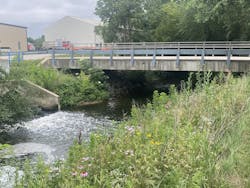Envirolok LLC
www.envirolok.com • 608.226.2565
Located just northwest of Chicago, the city of Wheaton, Illinois, is home to a string of parks and open spaces that wind their way around majestic tree lined streets. In addition to recreational benefits, these greenways create a natural buffer and provide access to Spring Brook and its reservoirs.
As with many urban waterways, bank erosion can be a constant battle. In addition to reduced water quality from sedimentation, failing banks can set the stage for growth of pioneer and invasive plant species. Invasive species, such as buckthorn and honeysuckle shade out the native understory plantings. Without the strong root matrix and vegetative cover of the understory to protect the banks, scouring and erosion further deteriorate the water’s edge, resulting in complete failure.
In 2012, the city of Wheaton partnered with Envirolok to address similar erosion issues along Spring Brook, at the Wheaton Sanitary Facilities. One of the more challenging locations included a failing slope that jeopardized the longevity of holding tanks as well as a vehicular bridge. Rainwater runoff, lack of understory vegetation, along with a scoured toe from high velocity outlet discharging directly at the bank all played a role in the bank failure. Through site visits with the client and detailed analysis with the engineering team, Envirolok proposed a fully engineered, vegetative solution, incorporating the geobag system with geogrid reinforcement. By embedding the system below the scour line, the system would be protected from impact and failure at the toe. Not only would the design provide the necessary strength and stability, but it would also act as a vegetated buffer, slowing, filtering and infiltrating runoff. Once implemented, the Envirolok system was vegetated with a mixture of native grasses, sedges and wildflowers to create a natural alternative to typical hard armored solutions, such as rip rap and concrete walls.
Fast forward 10 years, the Envirolok solution is thriving. There is a strong mix of native plants, such as monarda, yellow and purple coneflowers, little bluestem and fox sedge. Not only do the plantings look great and provide critical habitat, they are also functioning as a filter for runoff. In addition to great vegetation, the system is fully intact and showing no signs of breakdown, shifting or failure, even after large flood events in 2013, 2018 and 2020.







